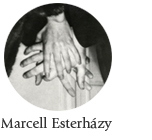Feketén-fehéren (In Black-and-White), (2010), video
Dark room, with a few seconds long film excerpt projected on the wall, showing a man ducking his head.
The large-skulled man with a careworn face is sitting on a train; behind him on the wall, a picture is seen with the inscription Mezőkövesd Spa. He is wearing thick-framed glasses; he lowers his head, then looks up, then down and up again, endlessly.
His prospects are limited to facing up and ducking his head in resignation — yes and no, hope and failure. The film loop is taken from the motion picture A sípoló macskakő (The Whistling Cobblestone) directed by Gyula Gazdag. The man is Mátyás Esterházy, the artist’s grandfather, who had a minor role in the closing scene of the film.
This is where a great deal of thoughts can come to our mind.
Starting from a minimalist gesture and taking advantage of another medium, Marcell Esterházy seems to repeat the pattern created by his father, writer Péter Esterházy, over a decade ago: the creation of a mythical father figure (in his magnum opus, Celestial Harmonies) and its disintegration (in its sequel, Revised Edition). Instead of the hermeneutic endeavour, aestheticization, baroque wordiness and elegiac approach, he chooses the gesture of revealing, condensed in just a few seconds. Everything described by the ancestors with the intricate and complex universes of history is pressed into one dual sign. This is what has left for the descendants, what is fact. This is how he appears to position himself against the dramatically rampant fate and imagination of the grandfather and father, respectively — against history and time. Inertness and resignation: the past becomes a motion picture similarly to the artist’s earlier video installation entitled v.n.p. v2.0 where his other grandfather appears as a closed, secretive and silent singularity.
In the dark room, the drama of the man from the film is stripped to a single gesture. Behind the harsh lines and despite the strong emanation we only perceive a yes and a no. The dimensions of history and fate have faded away; they have lost depth and complexity. The options of interpretation are converted to digital values, 1 and 0. We know that this man’s life had crumbled through the complex tension between loyalty and betrayal. What we see is a primary gesture, arbitrarily found and emphasized to us.
In the dark room, we perceive the mysterious traces of a tragic fate, featuring a single immensely expanded protagonist. (...)
László Garaczi
traduction: Csanád Pávai
